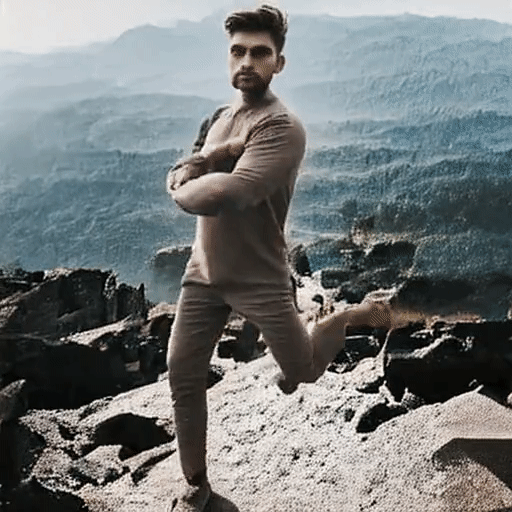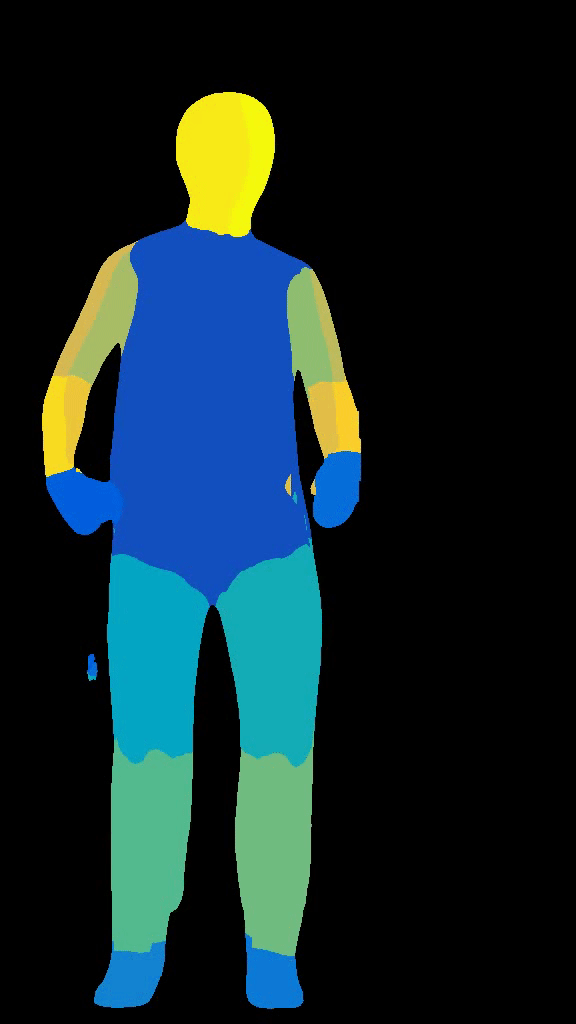magic-animate
Maintainer: lucataco

53

| Property | Value |
|---|---|
| Run this model | Run on Replicate |
| API spec | View on Replicate |
| Github link | View on Github |
| Paper link | View on Arxiv |
Create account to get full access
Model overview
magic-animate is a AI model for temporally consistent human image animation, developed by Replicate creator lucataco. It builds upon the magic-research / magic-animate project, which uses a diffusion model to animate human images in a consistent manner over time. This model can be compared to other human animation models like vid2openpose, AnimateDiff-Lightning, Champ, and AnimateLCM developed by Replicate creators like lucataco and camenduru.
Model inputs and outputs
The magic-animate model takes two inputs: an image and a video. The image is the static input frame that will be animated, and the video provides the motion guidance. The model outputs an animated video of the input image.
Inputs
- Image: The static input image to be animated
- Video: The motion video that provides the guidance for animating the input image
Outputs
- Animated Video: The output video of the input image animated based on the provided motion guidance
Capabilities
The magic-animate model can take a static image of a person and animate it in a temporally consistent way using a reference video of human motion. This allows for creating seamless and natural-looking animations from a single input image.
What can I use it for?
The magic-animate model can be useful for various applications where you need to animate human images, such as in video production, virtual avatars, or augmented reality experiences. By providing a simple image and a motion reference, you can quickly generate animated content without the need for complex 3D modeling or animation tools.
Things to try
One interesting thing to try with magic-animate is to experiment with different types of input videos to see how they affect the final animation. You could try using videos of different human activities, such as dancing, walking, or gesturing, and observe how the model translates the motion to the static image. Additionally, you could try using abstract or stylized motion videos to see how the model handles more unconventional input.
This summary was produced with help from an AI and may contain inaccuracies - check out the links to read the original source documents!
Related Models

magic-animate-openpose

8
The magic-animate-openpose model is an implementation of the magic-animate model that uses OpenPose input instead of DensePose. Developed by Luca Taco, this model allows you to animate human figures in images using an input video. It is similar to other models like vid2openpose, vid2densepose, and the original magic-animate model. Model inputs and outputs The magic-animate-openpose model takes in an image and a video as inputs. The image is the base image that will be animated, and the video provides the motion information to drive the animation. The model outputs an animated version of the input image. Inputs Image**: The input image to be animated Video**: The motion video that will drive the animation Outputs Animated Image**: The input image with the motion from the video applied to it Capabilities The magic-animate-openpose model can take an image of a human figure and animate it using the motion from an input video. This allows you to create dynamic, animated versions of static images. The model uses OpenPose to extract the pose information from the input video, which it then applies to the target image. What can I use it for? You can use the magic-animate-openpose model to create fun and engaging animated content. This could be useful for social media, video production, or even creative projects. By combining a static image with motion from a video, you can bring characters and figures to life in new and interesting ways. Things to try One interesting thing to try with the magic-animate-openpose model is to use it in combination with other models like real-esrgan-video to upscale and enhance the quality of the animated output. You could also experiment with using different types of input videos to see how the animation is affected, or try animating various types of figures beyond just humans.
Updated Invalid Date

animate-diff

256
animate-diff is a text-to-image diffusion model created by lucataco that can animate your personalized diffusion models. It builds on similar models like animate-diff, MagicAnimate, and ThinkDiffusionXL to offer temporal consistency and the ability to generate high-quality animated images from text prompts. Model inputs and outputs animate-diff takes in a text prompt, along with options to select a pretrained module, set the seed, adjust the number of inference steps, and control the guidance scale. The model outputs an animated GIF that visually represents the prompt. Inputs Path**: Select a pre-trained module Seed**: Set the random seed (0 for random) Steps**: Number of inference steps (1-100) Prompt**: The text prompt to guide the image generation N Prompt**: A negative prompt to exclude certain elements Motion Module**: Select a pre-trained motion model Guidance Scale**: Adjust the strength of the text prompt guidance Outputs Animated GIF**: The model outputs an animated GIF that brings the text prompt to life Capabilities animate-diff can create visually stunning, temporally consistent animations from text prompts. It is capable of generating a variety of scenes and subjects, from fantasy landscapes to character animations, with a high level of detail and coherence across the frames. What can I use it for? With animate-diff, you can create unique, personalized animated content for a variety of applications, such as social media posts, presentations, or even short animated films. The ability to fine-tune the model with your own data also opens up possibilities for creating branded or custom animations. Things to try Experiment with different prompts and settings to see the range of animations the model can produce. Try combining animate-diff with other Replicate models like MagicAnimate or ThinkDiffusionXL to explore the possibilities of text-to-image animation.
Updated Invalid Date

video-crafter

16
video-crafter is an open diffusion model for high-quality video generation developed by lucataco. It is similar to other diffusion-based text-to-image models like stable-diffusion but with the added capability of generating videos from text prompts. video-crafter can produce cinematic videos with dynamic scenes and movement, such as an astronaut running away from a dust storm on the moon. Model inputs and outputs video-crafter takes in a text prompt that describes the desired video and outputs a GIF file containing the generated video. The model allows users to customize various parameters like the frame rate, video dimensions, and number of steps in the diffusion process. Inputs Prompt**: The text description of the video to generate Fps**: The frames per second of the output video Seed**: The random seed to use for generation (leave blank to randomize) Steps**: The number of steps to take in the video generation process Width**: The width of the output video Height**: The height of the output video Outputs Output**: A GIF file containing the generated video Capabilities video-crafter is capable of generating highly realistic and dynamic videos from text prompts. It can produce a wide range of scenes and scenarios, from fantastical to everyday, with impressive visual quality and smooth movement. The model's versatility is evident in its ability to create videos across diverse genres, from cinematic sci-fi to slice-of-life vignettes. What can I use it for? video-crafter could be useful for a variety of applications, such as creating visual assets for films, games, or marketing campaigns. Its ability to generate unique video content from simple text prompts makes it a powerful tool for content creators and animators. Additionally, the model could be leveraged for educational or research purposes, allowing users to explore the intersection of language, visuals, and motion. Things to try One interesting aspect of video-crafter is its capacity to capture dynamic, cinematic scenes. Users could experiment with prompts that evoke a sense of movement, action, or emotional resonance, such as "a lone explorer navigating a lush, alien landscape" or "a family gathered around a crackling fireplace on a snowy evening." The model's versatility also lends itself to more abstract or surreal prompts, allowing users to push the boundaries of what is possible in the realm of generative video.
Updated Invalid Date

vid2densepose

4
The vid2densepose model is a powerful tool designed for applying the DensePose model to videos, generating detailed "Part Index" visualizations for each frame. This tool is particularly useful for enhancing animations, especially when used in conjunction with MagicAnimate, a model for temporally consistent human image animation. The vid2densepose model was created by lucataco, a developer known for creating various AI-powered video processing tools. Model inputs and outputs The vid2densepose model takes a video as input and outputs a new video file with the DensePose information overlaid in a vivid, color-coded format. This output can then be used as input to other models, such as MagicAnimate, to create advanced human animation projects. Inputs Input Video**: The input video file that you want to process with the DensePose model. Outputs Output Video**: The processed video file with the DensePose information overlaid in a color-coded format. Capabilities The vid2densepose model can take a video input and generate a new video output that displays detailed "Part Index" visualizations for each frame. This information can be used to enhance animations, create novel visual effects, or provide a rich dataset for further computer vision research. What can I use it for? The vid2densepose model is particularly useful for creators and animators who want to incorporate detailed human pose information into their projects. By using the output of vid2densepose as input to MagicAnimate, you can create temporally consistent and visually stunning human animations. Additionally, the DensePose data could be used for various computer vision tasks, such as human motion analysis, body part segmentation, or virtual clothing applications. Things to try One interesting thing to try with the vid2densepose model is to combine it with other video processing tools, such as Real-ESRGAN Video Upscaler or AniPortrait: Audio-Driven Synthesis of Photorealistic Portrait Animation. By stacking these models together, you can create highly detailed and visually compelling animated sequences.
Updated Invalid Date